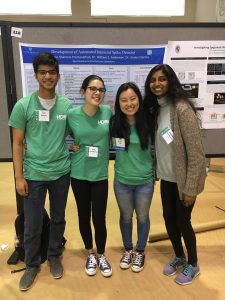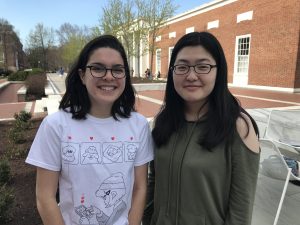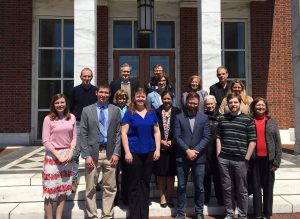New exploratory method for exploring brain regions frequency features in neural data. Led by Ph.D. candidate, Macauley Breault. Click here to view.
Continuing to change the face of STEM: Sridevi Sarma receives second consecutive mentoring grant from L’Oreal
Sridevi Sarma, associate professor of biomedical engineering, associate director of the Institute for Computational Medicine, and 2008 L’Oréal USA For Women In Science (FWIS) Fellow has been awarded a 2018 “Changing the Face of STEM” (CTFS) grant from L’Oreal to support her mentoring efforts.
Sarma is using her second CTFS grant to continue hosting a physics project with the Girl Scouts of Central Maryland. In spring 2018, Sarma and PhD candidate Macauley Breault developed and executed a fun and competitive STEM activity that brought together more than two dozen Girl Scout Cadette troops (ages 10-12) at Johns Hopkins University. The CTFS grant will allow Sarma to repeat this successful project in 2019.
The Girl Scout Roller Coaster Contest challenges participants’ engineering skills as they compete to build roller coasters out of household materials. Led by Sarma and a dozen female PhD candidates in her lab, each troop will learn about the physics of roller coasters, which will then help them to design a model for a chance to win tickets to Six Flags America.
Now in its third year, the CTFS program supports former L’Oréal USA For Women in Science fellows in their efforts to inspire the next generation of girls in STEM. Members of the L’Oréal USA FWIS alumni network were invited to apply for $2,500 grants to help fund new or existing mentoring projects in their communities. The awards will be administered by the American Association for the Advancement of Science (AAAS), official partner of the L’Oréal USA For Women in Science program.
“We are committed to inspiring the next generation of women in STEM through our For Women in Science program,” said Lauren Paige, Vice President of Public Affairs & Strategic Initiatives at L’Oréal USA. “Our Changing the Face of STEM grant program builds on this long-time commitment and supports our fellows in their continuous work promoting STEM education in communities across the United States.”
A complete list of 2018 CTFS grant winners and their projects can be found here.
Kristin Gunnarsdottir receives American Epilepsy Society fellowship
Kristin Gunnarsdottir, a PhD student in the lab of ICM associate director and associate professor of biomedical engineering, Sridevi Sarma, has been awarded a fellowship from The American Epilepsy Society for the 2018-2019 academic year for her research titled, “A Novel Tool for Localizing the Epileptogenic Zone.”
Gunnarsdottir, who is pursuing her PhD in biomedical engineering, is developing a computational tool for seizure localization and treatment in patients with medically refractory epilepsy (MRE). The tool will create precise and accurate maps of the seizure onset region from invasive EEG recordings in MRE patients by (i) providing a more dense brain coverage with estimated invasive EEG recordings, and (ii) using network modeling to reveal the onset region in the form of heat maps. Ultimately, these maps will guide multiple laser ablations of specific brain areas.
Raina D’Aleo to attend MIT’s ‘Brains, Minds and Machines’ course

Raina D’Aleo, a neuroscience PhD student in the lab of Sridevi Sarma, associate director of the Institute for Computational Medicine, has been accepted into the 2018 Brains, Minds and Machines advanced research training course hosted by the Massachusetts Institute of Technology Center for Brains Minds and Machines.
The intensive three-week course held at at the University of Chicago’s Marine Biological Laboratory in Woods Hole, MA, will give advanced students a “deep end” introduction to the problem of intelligence – how the brain produces intelligent behavior and how we may be able to replicate intelligence in machines.
The class discussions will cover a range of topics, complemented with workshops and tutorials to gain hands-on experience with these topics. The course aims to cross-educate computer engineers and neuroscientists, with the core presentations given jointly by neuroscientists, cognitive scientists, and computer scientists and collaborative research projects performed in teams that combine students with diverse backgrounds.
ICM Undergraduates represent Sarma Lab at DREAMS 2018

Four students in the ICM lab of Sridevi Sarma, associate director of ICM and associate professor of biomedical engineering, participated in DREAMS 2018, an undergraduate research day that took place last Friday, April 27. Anil Palepu, Julia Costacurta and Kathy Hu, sophomores in the department of biomedical engineering and Sharmini Premanathan, a senior in the department of neuroscience, presented research projects conducted under the direction of Sarma at the event.
Sarma’s lab integrates aspects of computational medicine and neuroscience by using computational methods to model the central nervous system. The students’ projects spanned a variety of neuromedical research areas, including sleep stage scoring, inter-ictal discharge detection for epilepsy, and optima control for brain machine interface design.
DREAMS 2018 is held annually to showcases the research, scholarly, and creative projects of JHU’s undergraduate students. Three hundred students participated in this year’s event which included 25 arts and humanities presentations, 45 public health & social science posters, 100 basic science and 55 engineering posters & presentations.
ICM undergraduates receive Center for Educational Resources Technology Fellowship
 Julia Costacurta and Jung Min Lee, sophomores in the Institute for Computational Medicine and the department of biomedical engineering, received a technology fellowship from the Center for Educational Resources for their research proposal, “An Interactive Set of Resources for Learning Control Theory.” The fellowship provides funding to support the proposed research under the direction of Sridevi Sarma, associate director of the Institute for Computational Medicine and associate professor of biomedical engineering.
Julia Costacurta and Jung Min Lee, sophomores in the Institute for Computational Medicine and the department of biomedical engineering, received a technology fellowship from the Center for Educational Resources for their research proposal, “An Interactive Set of Resources for Learning Control Theory.” The fellowship provides funding to support the proposed research under the direction of Sridevi Sarma, associate director of the Institute for Computational Medicine and associate professor of biomedical engineering.
The goal of the project is to create a comprehensive set of interactive resources that will help students learning control theory to understand the course material and the applications of what they are learning. Costacurta and Lee aim to expand on a previous project completed by fellow Elli Tian, which involved the development of applets to visualize real-world control theory examples.
The project also aims to develop a set of tutorials and exercises in MATLAB, so that students can become more aware of the tools available in MATLAB to implement real-world applications of control theory.
“We hope that if students take advantage of these resources, they will be able to better understand the material and possibly apply control theory concepts in their future studies and work,” said Costacurta.
The Center for Educational Resources’ Technology Fellows Program is a mini-grant initiative that enables faculty to partner with technology savvy students to develop resources that enhance pedagogy, increase or facilitate access to course content, encourage active learning, promote critical thinking, or support student collaboration.
Macauley Breault receives second consecutive ARCS Scholarship
 Macauley Breault has been named an ARCS Scholar for the 2018-2019 academic year. This marks the second consecutive year that Breault has been awarded an Achievement Reward for College Scientists (ARCS) Scholarship to support her research in the lab of Sridevi Sarma, associate director of the Institute for Computational Medicine and associate professor of biomedical engineering.
Macauley Breault has been named an ARCS Scholar for the 2018-2019 academic year. This marks the second consecutive year that Breault has been awarded an Achievement Reward for College Scientists (ARCS) Scholarship to support her research in the lab of Sridevi Sarma, associate director of the Institute for Computational Medicine and associate professor of biomedical engineering.
Breault, a PhD student in biomedical engineering, is focusing on building a brain network of non-motor regions that encode how movements are modulated using data collected from epileptic patients in collaboration with Cleveland Clinic.
Breault’s other research interest stems from personal experience. A sufferer of chronic pain, she hopes to impact research in the field by constructing a model of the dorsal horn that takes into account how treatments such as neural stimulation affect pain regulation.
ARCS Foundation provides unrestricted funding to talented, motivated American graduate and undergraduate students in science and engineering to create new knowledge and innovative technologies. ARCS scholars have been awarded more than 3600 patents and have gone on to found more than 1800 new companies.
A design challenge full of twists and turns
 More than two dozen members of the Girl Scouts of Central Maryland came to Johns Hopkins University’s Homewood campus Saturday to design and build miniature roller coasters out of cardboard boxes, pipe insulation tubing, cups, tape, and other household materials—and to learn about the field of engineering along the way.
More than two dozen members of the Girl Scouts of Central Maryland came to Johns Hopkins University’s Homewood campus Saturday to design and build miniature roller coasters out of cardboard boxes, pipe insulation tubing, cups, tape, and other household materials—and to learn about the field of engineering along the way.
The elementary- and middle-school-age Girl Scouts were challenged to construct 5-foot roller coasters that incorporated as many “thrill” elements as possible—tunnels, hills, banked curves, vertical loops, helixes, in-line twists—and then to transport marbles through the contraptions.
Sridevi Sarma, associate professor of biomedical engineering and associate director of the Institute for Computational Medicine, hosted the event as part of L’Oréal USA’s Changing the Face of STEM Mentoring Grant, which she received in September.
“We want to introduce these young girls to science and engineering in a way that will keep them engaged,” Sarma said. “We’re taking the concept of energy and breaking it down into basic ideas that they will understand, and we’re reinforcing those concepts through the process of building a roller coaster.”
To ensure the event stayed on track, nine female Johns Hopkins engineering students guided the girls through the design process from brainstorming to realization. Each team, organized by troop number, worked within an allotted timeframe to build the fastest and most creative coaster.
“We’re working as a team and having fun, all while learning how to be an engineer and build things,” said Malai Bowman from Troop 736.
Sridevi Sarma featured on IEEE Brain podcast
Sridevi Sarma, ICM core faculty member and associate professor of biomedical engineering at Johns Hopkins University, was recently a guest on the IEEE Brain Initiative podcast series, where she discussed her background in electrical engineering and control theory, her current research on mathematical models of neurological diseases, and the importance of encouraging young women to pursue careers in engineering. Read some of the highlights from Sarma’s interview below, or listen to the full IEEE Brain podcast on SoundCloud.
The brain is such a huge subject. What is your area of focus?
I’m an engineer by training—an electrical engineer—but the focus of my research is on neurological disorders. So what we try to do is understand the electrical patterns in specific neural circuits that are affected by disease, like Parkinson’s Disease, epilepsy, dystonia, and so forth. We really try to understand how you go from normal to disease—what actually changes in the brain.
As an electrical engineer, how do you get pulled into neuroscience?
I did my bachelor’s, master’s, and PhD entirely in electrical engineering, and I’m a control theorist by training, so I did mathematics and theory. So how did I get interested in neuroscience? This would lead to, in general, where can electrical engineers play a huge role? As a control theorist, people who train like me go work for Boeing, or Ford, where they’re building controllers to control airplanes and cars and other kinds of electrical and mechanical systems.
For me, the neural circuit is a dynamic system, and what do I want to do? Well I want to control the electrical patterns coming out of this system to make it do something I want it to do. So now I need to model what this neural circuit is, just like an electrical engineer will model the central dynamics of an airplane and then figure out how to control it. I see this whole deep brain stimulation as just an exogenous input that we can design to control this dynamic system. So at the end of the day, my training is perfectly aligned for the idea of controlling brain circuits with electrical stimulation. That’s just one example of how electrical engineers can play a huge role.
You mentioned Parkinson’s earlier. What are you doing in that area?
If you are a healthy person, there are specific neural circuits in the brain that control your movements, and there are electrical patterns that help us move the way we move, freely and in a coordinated way. What we want to understand is how those change when you have, say, Parkinson’s disease, which is a movement disorder. These people can’t move properly; they have tremors and rigidity. So we really want to understand what has changed in those patterns, and once we understand that, what we try to do is say, “Okay, now if I were to electrically stimulate that region of the brain, how can I change those patterns to make a Parkinson’s patient move more like a healthy patient? This idea of putting electrical stimulation in the brain is known as neurostimulation, or deep brain stimulation, and it’s actually a therapy that’s currently used to treat Parkinson’s disease today.
There is a therapy out there already. So what are you adding to the equation?
So deep brain stimulation, or DBS, has been FDA approved and clinically used for the last several decades. But what’s astonishing is that after all this time, people really don’t know why it works. So they put this electrode in the brain, they turn it on, and it looks like a miracle has happened—the person’s symptoms have really suppressed—but they don’t understand what it did because it’s very hard to measure activity in the brain while you’re stimulating it. So what we do in our lab is try to answer this question by building mathematical models that characterize these circuits that are somewhat realistic, then we put in our artificial electrodes, stimulate our computational brain, if you will, and we try to understand what it’s doing. And now, since we know what a healthy person looks like, we try to see, is the stimulation trying to restore your patterns, or is it doing something different that happens to be therapeutic? So these are the kinds of questions we ask.
Promoting women in science is a big topic at the moment. Can you talk about your own experiences?
For myself, being an electrical engineer and going through my undergrad and graduate years, the number of women just declined the more senior I became. For example, during my undergraduate years I had one female professor in the fifty-plus courses that I took. One female. So I had no role models in terms of professors or even teaching assistants, and there were very few colleagues. Sometimes it can be very discouraging when you don’t see people like you doing the same things, and it might make you question yourself. But say you get past that, which I did. What becomes difficult as a woman in engineering or science going into academia or industry is, obviously, if you want to have a family. You’re worried about the timing of things — now you’re getting into your 30s, now you’re getting into your 40s. Here you are competing with men who don’t have children who can put in all the hours that maybe you can’t because you have children. So I think it’s important to do a couple things for women in science, because I absolutely believe that some of the best scientists and engineers that I’ve encountered are women, is to provide opportunities to deal with some of these issues that are very specific to women. I think it’s important to step back and think very carefully to understand individual circumstances, whether it’s gender-specific or race-specific. We need to be really careful of understanding how to help people in different groups and promote them.
What would you say to young women and girls considering the field?
For young girls who are considering the field, I would show them what I do because I think research is so exciting. It’s what makes me wake up and smile every single day — to see what my students are able to accomplish, what questions we can answer, and results, they just make you feel good. They’re kind of like an antidepressant. And it’s exciting. Being in a biomedical engineering field, you see things that might actually help people, but you’re using mathematics and engineering tools to reach that objective. I think that would appeal a lot to young women and girls today. Being an engineer is not about tinkering with trucks or toys, which is fine, but maybe that’s not what may come to their mind. When I was a young girl, when someone said ‘engineer’ I would think of somebody changing a light bulb. I had no idea what an engineer is, but today, engineers can do so many different things and I think a lot of those things would appeal to young girls. So I would want to show them the kinds of things engineers do to encourage them to pursue it.
Sri, what’s your personal goal?
My personal goal is to see my research translated into the clinic and be used to help patients with any kind of neurological disorder.
Sridevi Sarma co-edits book, Dynamic Neuroscience: Statistics, Modeling, and Control
 Sridevi Sarma, Associate Director of the Institute for Computational Medicine, is the co-editor of a newly published book titled, Dynamic Neuroscience: Statistics, Modeling, and Control that sheds new light on the field of neuroscience. The book, co-edited with Zhe Chen, Assistant Professor in the Departments of Psychiatry and Neuroscience and Physiology at New York University School of Medicine, capitalizes on the knowledge and experience of experts in the field of neuroscience by presenting recent advances in computational research methods and discussing important research issues in neural data analysis.
Sridevi Sarma, Associate Director of the Institute for Computational Medicine, is the co-editor of a newly published book titled, Dynamic Neuroscience: Statistics, Modeling, and Control that sheds new light on the field of neuroscience. The book, co-edited with Zhe Chen, Assistant Professor in the Departments of Psychiatry and Neuroscience and Physiology at New York University School of Medicine, capitalizes on the knowledge and experience of experts in the field of neuroscience by presenting recent advances in computational research methods and discussing important research issues in neural data analysis.
Dynamic Neuroscience: Statistics, Modeling, and Control takes an interdisciplinary approach with chapters written by computational and experimental researchers as well as those at the interface. The chapter titled, “Characterizing Complex Human Behaviors and Neural Responses Using Dynamic Models,” authored by Sarma and Pierre Sacre, Postdoctoral Fellow in Sarma’s ICM lab, proposes a framework for analyzing data and addressing challenges that arise in neuroscience experiments with human subjects.
Dynamic Neuroscience: Statistics, Modeling, and Control is published by Springer and can be found here.

